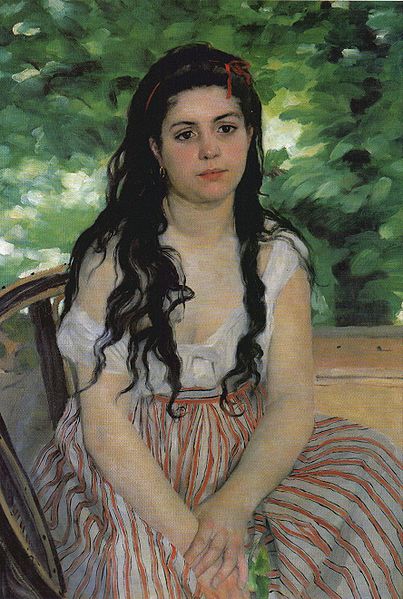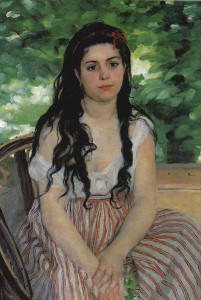Bohemianism.


Pierre-Auguste Renoir, The Bohemian (or Lise the Bohemian), 1868, oil on canvas, Berlin, Germany: Alte Nationalgalerie
Bohemianism refers to the practice of an unconventional lifestyle, often in the company of like-minded people, involving musical, artistic or literary pursuits, with few permanent ties. Bohemians can be wanderers, adventurers, or vagabonds.
While the term Bohemian actually means origination from the Eastern European and Slavic country of Bohemia, it was later used colloquially by the French and then in the English language in the nineteenth century to describe the non-traditional lifestyles of marginalized and impoverished artists, writers, journalists, musicians, and actors in major European cities. Bohemians, in this colloquial use of the word, were associated with unorthodox or anti-establishment political or social viewpoints, which were often expressed through free love, frugality, and/orvoluntary poverty.
Origin of the term
The term Bohemianism emerged in France in the early 19th century when artists and creators began to concentrate in the lower-rent, lower class Romani (Gypsy) neighborhoods. The term bohémien was a common term for the Romani people of France, who had reached Western Europe via Bohemia.
Literary Bohemians were associated in the French imagination with roving Romanis (called bohemians because they were believed to have arrived from Bohemia), outsiders apart from conventional society and untroubled by its disapproval. The term carries a connotation of arcane enlightenment (the opposite of Philistines), and also carries a less frequently intended, pejorative connotation of carelessness about personal hygiene and marital fidelity. The Spanish Romani girl in the French opera Carmen set in Seville, is referred to as a bohémienne in Meilhac and Halévy’s libretto (1875).
The term ‘Bohemian’ has come to be very commonly accepted in our day as the description of a certain kind of literary gypsy, no matter in what language he speaks, or what city he inhabits …. A Bohemian is simply an artist or littérateur who, consciously or unconsciously, secedes from conventionality in life and in art. (Westminster Review, 1862)
Henri Murger’s collection of short stories Scènes de la Vie de Bohème (Scenes of Bohemian Life), published in 1845, was written to glorify and legitimize Bohemia. Murger’s collection formed the basis of Giacomo Puccini’s opera La bohème (1896). (Puccini’s work, in turn, became Jonathan Larson’s source material for the musical Rent, later a feature film of the same name. Like Puccini, Larson explores a Bohemian enclave in a dense urban area, in this case, New York City at the end of the 20th century. The show features a song, “La Vie Boheme,” which celebrates postmodern Bohemian culture.)
In English, Bohemian in this sense was initially popularized in William Makepeace Thackeray’s novel, Vanity Fair, published in 1848. Public perceptions of the alternative life-styles supposedly led by artists were further molded by George du Maurier’s highly romanticized best-selling novel of Bohemian culture Trilby (1894). The novel outlines the fortunes of threeexpatriate English artists, their Irish model, and two very colorful Eastern European musicians, in the artists’ quarter of Paris.
In Spanish literature, the Bohemian impulse can be seen in Ramón del Valle-Inclán’s play Luces de Bohemia (Bohemian Lights), published in 1920.
American bohemianism
In 1845, Bohemian nationals began to emigrate to the United States, and from 1848 the wave included some of the radicals and ex-priests who had wanted a constitutional government. In New York City in 1857, a group of some 15–20 young, cultured journalists flourished as self-described “Bohemians” until the American Civil War began in 1860. Similar groups in other cities were broken up as well—reporters spread out to report on the conflict. During the war, correspondents began to assume the title “Bohemian,” and newspapermen in general took up the moniker. “Bohemian” became synonymous with “newspaper writer”. In 1866, war correspondent Junius Henri Browne who wrote for the New York Tribune and Harper’s Magazine described as “Bohemian” journalists such as himself as well as the few carefree women and lighthearted men he encountered during the war years.
San Francisco journalist Bret Harte first wrote as “The Bohemian” in The Golden Era in 1861, with this persona taking part in many satirical doings, the lot published in his book Bohemian Papers in 1867. Harte wrote “Bohemia has never been located geographically, but any clear day when the sun is going down, if you mount Telegraph Hill, you shall see its pleasant valleys and cloud-capped hills glittering in the West…” Mark Twain included himself and Charles Warren Stoddard in the Bohemian category in 1867. By 1872, when a group of journalists and artists who gathered regularly for cultural pursuits in San Francisco were casting about for a name, the term “Bohemian” became the main choice, and theBohemian Club was born. Club members who were established and successful, pillars of their community, respectable family men, redefined their own form of bohemianism to include people like themselves who were bons vivants, sportsmen, and appreciators of the fine arts. Club member and poet George Sterling responded to this redefinition:
Any good mixer of convivial habits considers he has a right to be called a Bohemian. But that is not a valid claim. There are two elements, at least, that are essential to Bohemianism. The first is devotion or addiction to one or more of the Seven Arts; the other is poverty. Other factors suggest themselves: for instance, I like to think of my Bohemians as young, as radical in their outlook on art and life; as unconventional, and, though this is debatable, as dwellers in a city large enough to have the somewhat cruel atmosphere of all great cities.
Despite his views, Sterling associated very closely with the Bohemian Club, and caroused with artist and industrialist alike at the Bohemian Grove.
Oscar Ferdinand Telgmann and George Frederick Cameron wrote the song The Bohemian in the 1889 opera Leo, the Royal Cadet
I’ve written some Psalms and some songs, I’ve dabbled in most of the arts:
Quixote-like, righted some wrongs in fact, I have played many parts.
I have seen both the bright and the dark of the world and the things that are its,
like the dove that flew forth from the ark: In a word, I am given to flits.
For the life of a rover is mine, A rover by land and by sea:
With a lady to love and a flagon of wine, oh, the world is the village for me!
To-day, as you see, I am here, Enjoying my pipe and my bowl:
To-morrow, and I may appear inscribing my name on the Pole.
The next day may see me once more, content as a hog upon ice,
Far down on the Florida shore, existing on bacon and rice.
I have hobnobbed with peasant and king, with a hundred to run at my call;
I have seen the sweet flowers of spring lose their odor and grace before Fall.
I have loved with the warmth of the boy and adored with the passion of man,
But the altar’s it’s drop of alloy, so I came buck to where I began!
Chorus. For the life of a rover is mine etc.
The impish American writer and Bohemian Club member Gelett Burgess, who coined the word “blurb” among other things, supplied this description of the amorphous place called Bohemia:
To take the world as one finds it, the bad with the good, making the best of the present moment—to laugh at Fortune alike whether she be generous or unkind—to spend freely when one has money, and to hope gaily when one has none—to fleet the time carelessly, living for love and art—this is the temper and spirit of the modern Bohemian in his outward and visible aspect. It is a light and graceful philosophy, but it is the Gospel of the Moment, this exoteric phase of the Bohemian religion; and if, in some noble natures, it rises to a bold simplicity and naturalness, it may also lend its butterfly precepts to some very pretty vices and lovable faults, for in Bohemia one may find almost every sin save that of Hypocrisy. …His faults are more commonly those of self-indulgence, thoughtlessness, vanity and procrastination, and these usually go hand-in-hand with generosity, love and charity; for it is not enough to be one’s self in Bohemia, one must allow others to be themselves, as well. …What, then, is it that makes this mystical empire of Bohemia unique, and what is the charm of its mental fairyland? It is this: there are no roads in all Bohemia! One must choose and find one’s own path, be one’s own self, live one’s own life.
In New York City, an organization of musicians was formed in 1907 by pianist Rafael Joseffy with friends such as Rubin Goldmark, called the “The Bohemians (New York Musicians’ Club)”.
People
The term has become associated with various artistic or academic communities and is used as a generalized adjective describing such people, environs, or situations: bohemian (boho—informal) is defined in The American College Dictionary as “a person with artistic or intellectual tendencies, who lives and acts with no regard for conventional rules of behavior.”
Many prominent European and American figures of the last 150 years belonged to the bohemian counterculture, and any comprehensive ‘list of bohemians’ would be tediously long. Bohemianism has been approved of by some bourgeois writers such as Honoré de Balzac, but most conservative cultural critics do not condone bohemian lifestyles.
The New York Times columnist David Brooks contends that much of the cultural ethos of upper-class Americans is Bohemian-derived, coining the paradoxical term “Bourgeois Bohemians” or “Bobos.”
The Bombshell Manual of Style author, Laren Stover, breaks down the Bohemian into five distinct mind-sets/styles in Bohemian Manifesto: a Field Guide to Living on the Edge. The Bohemian is “not easily classified like species of birds,” writes Stover, noting that there are crossovers and hybrids. The five types are:
- Nouveau: bohemians with money who attempt to join traditional bohemianism with contemporary culture
- Gypsy: drifters, neo-hippies, and others with nostalgia for previous, romanticized eras
- Beat: also drifters, but non-materialist and art-focused
- Zen: “post-beat,” focus on spirituality rather than art
- Dandy: no money, but try to appear as if they have it by expensive or rare items – such as brands of alcohol
In the United States, the bohemian impulse can be seen in the 1960s hippie counterculture (which was in turn informed by the Beat generation via writers such as William S. Burroughs,Allen Ginsberg, and Jack Kerouac).
Rainbow Gatherings may be seen as another contemporary worldwide expression of the bohemian impulse.
Bohemian communities in the past
By extension, Bohemia meant any place where one could live and work cheaply, and behave unconventionally; a community of free souls beyond the pale of respectable society. Several cities and neighborhoods came to be associated with bohemianism in the nineteenth and early twentieth centuries: In Europe: Montmartre and Montparnasse in Paris; Chelsea, Fitzrovia, and Soho in London; Schwabing in Munich; Skadarlija in Belgrade; Tabán in Budapest. In the United States: Greenwich Village in New York City, and Tiburon, California.
In Australia: Potts Point, Sydney.
Source: en.wikipedia.org


This Post Has 0 Comments